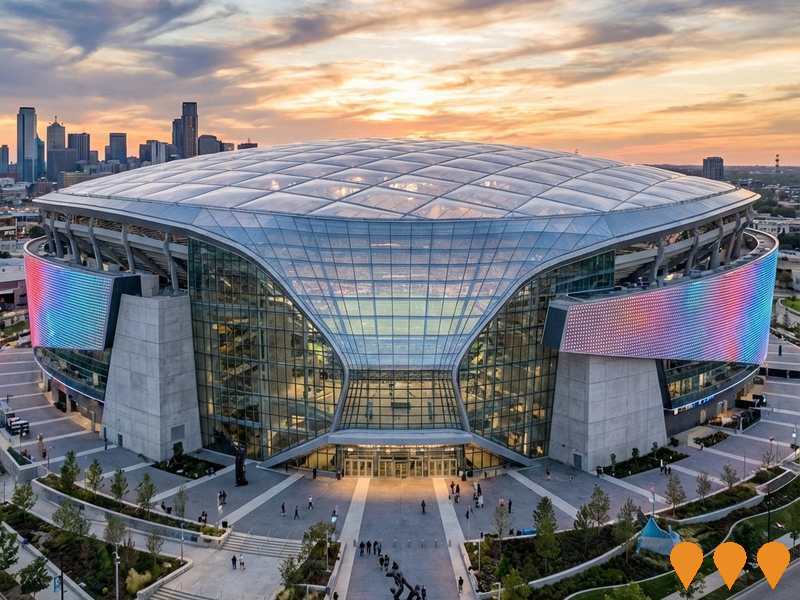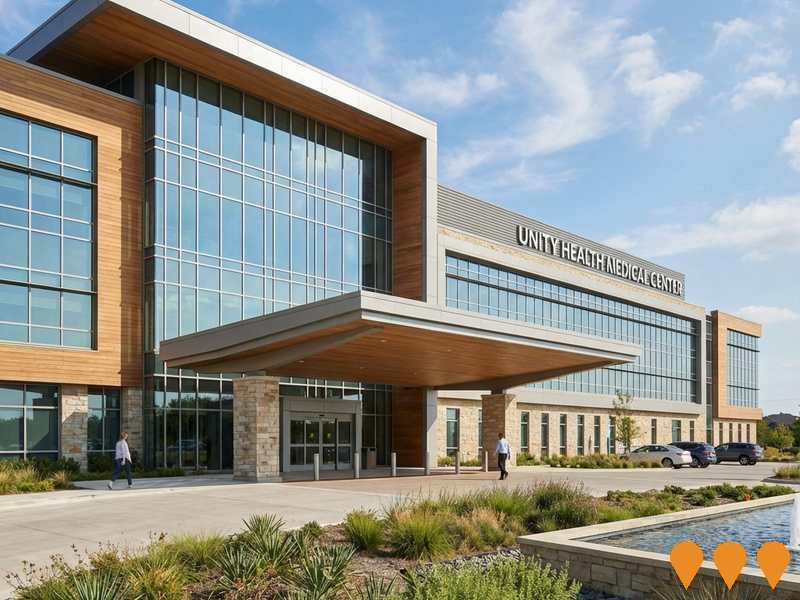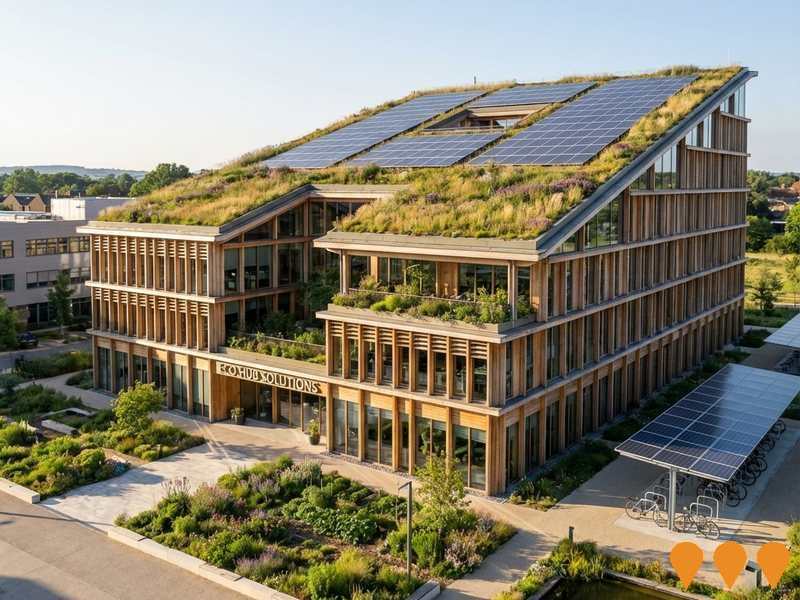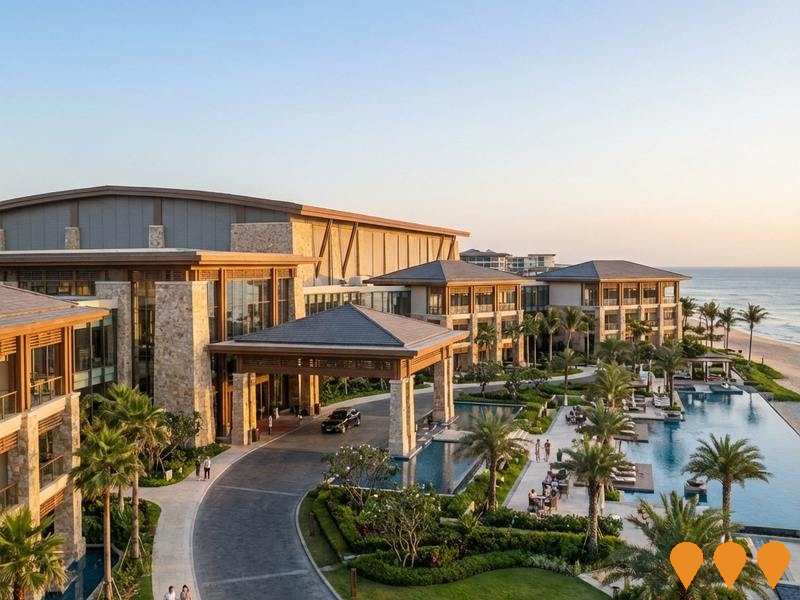Chart Color Schemes
est. as @ -- *
ABS ERP | -- people | --
2021 Census | -- people
Sales Activity
Curious about local property values? Filter the chart to assess the volume and appreciation (including resales) trends and regional comparisons, or scroll to the map below view this information at an individual property level.
Find a Recent Sale
Sales Detail
Population
An assessment of population growth drivers in South Coogee reveals an overall ranking slightly below national averages considering recent, and medium term trends
South Coogee's population is approximately 5,750 as of Aug 2025. This figure represents an increase of 139 people since the 2021 Census, which reported a population of 5,611. The change is inferred from ABS estimates of 5,750 in June 2024 and three new validated addresses since the Census date. This results in a density ratio of 5,088 persons per square kilometer, placing South Coogee in the top 10% of national locations assessed by AreaSearch. Over the past decade, South Coogee has shown resilient growth with a compound annual growth rate of 0.1%, outperforming its SA3 area. Overseas migration contributed approximately 92.4% of overall population gains during recent periods.
AreaSearch uses ABS/Geoscience Australia projections for each SA2 area, released in 2024 with a base year of 2022. For areas not covered by this data, AreaSearch utilises NSW State Government's SA2 level projections, released in 2022 with a base year of 2021. Growth rates by age group from these aggregations are applied to all areas for years 2032 to 2041. Based on projected demographic shifts, South Coogee is expected to grow by approximately 523 persons to 2041, representing a gain of around 9.1% over the 17-year period.
Frequently Asked Questions - Population
Development
AreaSearch assessment of residential development drivers sees a low level of activity in South Coogee, placing the area among the bottom 25% of areas assessed nationally
South Coogee has granted approximately 12 residential properties approval annually. Between FY-21 and FY-25, a total of 64 homes were approved, with an additional 2 approved so far in FY-26.
The area has experienced population decline while maintaining adequate housing supply relative to demand, resulting in a balanced market with good buyer choice. New properties are constructed at an average value of $1,095,000, indicating a focus on the premium segment. Compared to Greater Sydney, South Coogee has 16.0% less new development per person and ranks among the 36th percentile nationally, offering more limited choices for buyers and supporting demand for existing dwellings. This level is below average nationally, reflecting the area's maturity and possible planning constraints. New development consists of 40.0% standalone homes and 60.0% attached dwellings, providing accessible entry options for downsizers, investors, and entry-level buyers.
With around 527 people per dwelling approval, South Coogee shows a developed market. Population forecasts indicate South Coogee will gain 523 residents by 2041. If current development rates continue, housing supply may not keep pace with population growth, potentially increasing competition among buyers and supporting stronger price growth.
Frequently Asked Questions - Development
Infrastructure
South Coogee has strong levels of nearby infrastructure activity, ranking in the top 30% nationally
Area infrastructure changes significantly impact performance. Two projects identified by AreaSearch may affect the area: Woomera Reserve Upgrade - Little Bay, Sydney Metro Eastern Suburbs Extension, Google Pacific Connect - Tabua and Honomoana Cable Landing Infrastructure, South Coogee to Lurline Bay Coastal Walk Connection. Key details follow.
Professional plan users can use the search below to filter and access additional projects.
INFRASTRUCTURE SEARCH
 Denotes AI-based impression for illustrative purposes only, not to be taken as definitive under any circumstances. Please follow links and conduct other investigations from the project's source for actual imagery. Developers and project owners wishing us to use original imagery please Contact Us and we will do so.
Denotes AI-based impression for illustrative purposes only, not to be taken as definitive under any circumstances. Please follow links and conduct other investigations from the project's source for actual imagery. Developers and project owners wishing us to use original imagery please Contact Us and we will do so.
Frequently Asked Questions - Infrastructure
Sydney Metro Eastern Suburbs Extension
A strategic future extension of the Sydney Metro network (likely Metro West) to the south-eastern suburbs. Identified in the 'South East Sydney Transport Strategy' to 2056, the corridor proposes connecting the CBD/Hunter Street to Zetland (Green Square), Randwick, Maroubra, and La Perouse. The project aims to alleviate capacity constraints on the existing light rail and bus networks and support high-density residential growth in the Green Square precinct.
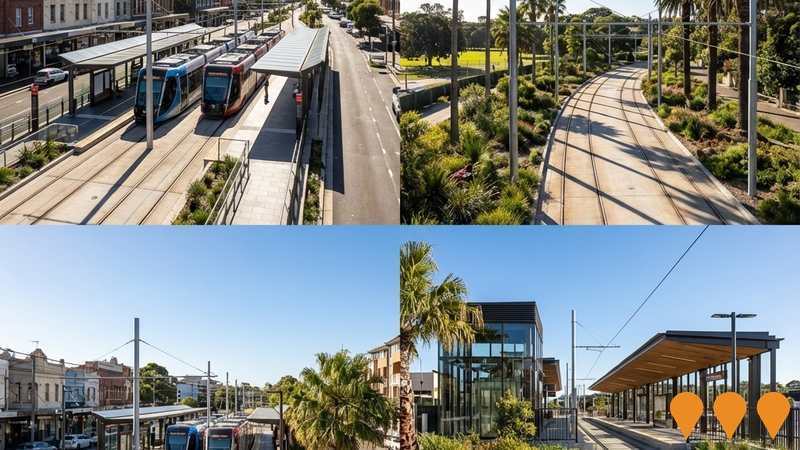
Randwick Health & Innovation Precinct
Australia's largest integrated health, education and research precinct. Combines the completed Prince of Wales Hospital Acute Services Building ($870M), the UNSW Health Translation Hub ($600M, 35,600sqm translational research and education building due late 2025/early 2026), and Sydney Children's Hospital Stage 1 & Minderoo Children's Comprehensive Cancer Centre ($658M, due late 2025). Total investment exceeds $2.1 billion. Co-locates UNSW Sydney, Prince of Wales Hospital, Sydney Children's Hospital, Royal Hospital for Women, nine medical research institutes and industry partners.
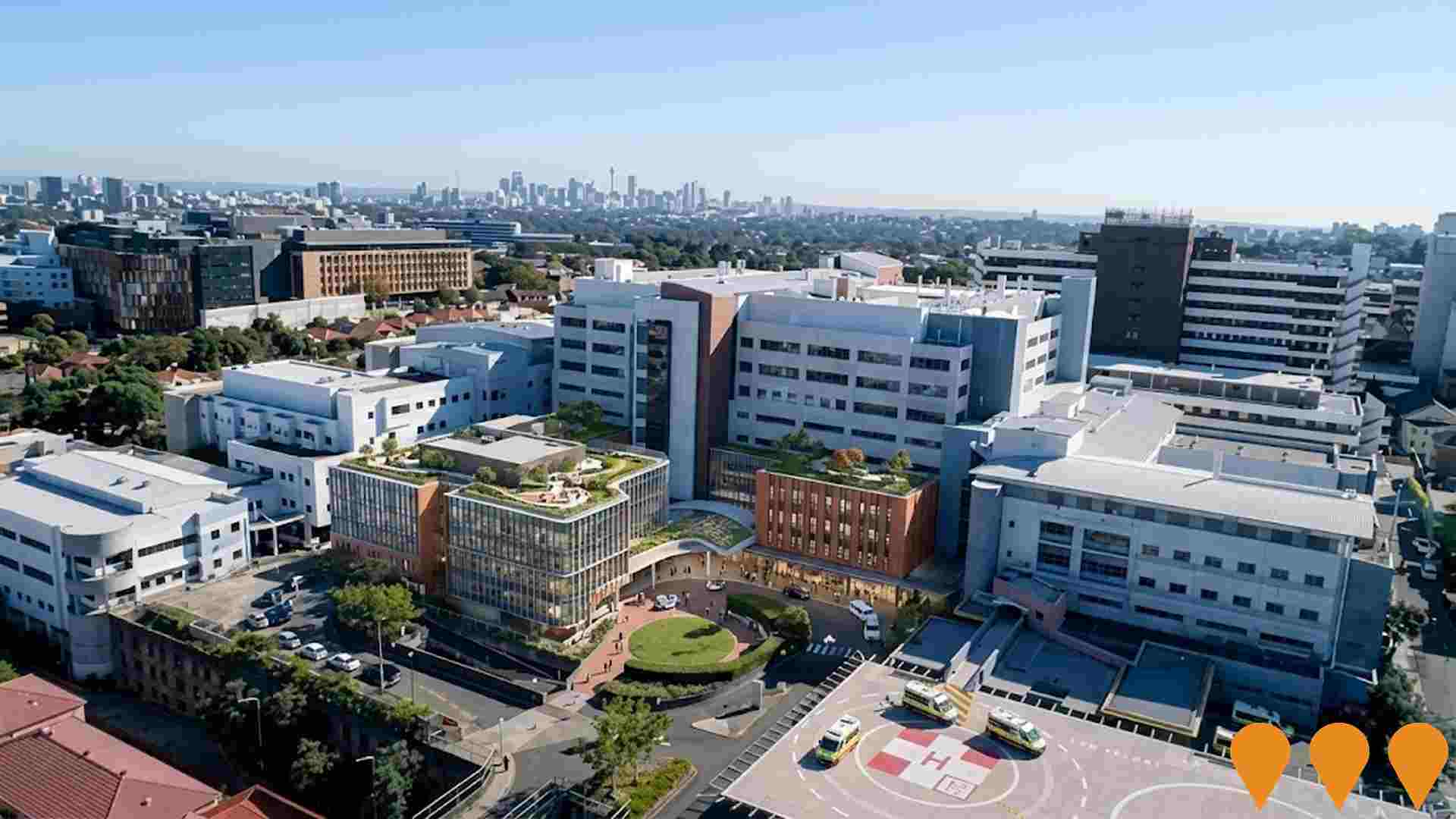
Sydney Children's Hospital Stage 1 & Minderoo Children's Comprehensive Cancer Centre
A $658 million redevelopment delivering a new 12-storey children's hospital and the Minderoo Children's Comprehensive Cancer Centre, integrating world-leading clinical care, research, and education. Features include 200 beds, expanded emergency department, neurosciences centre, and advanced paediatric cancer facilities. Construction is complete, with commissioning underway and opening to patients expected in late 2025.
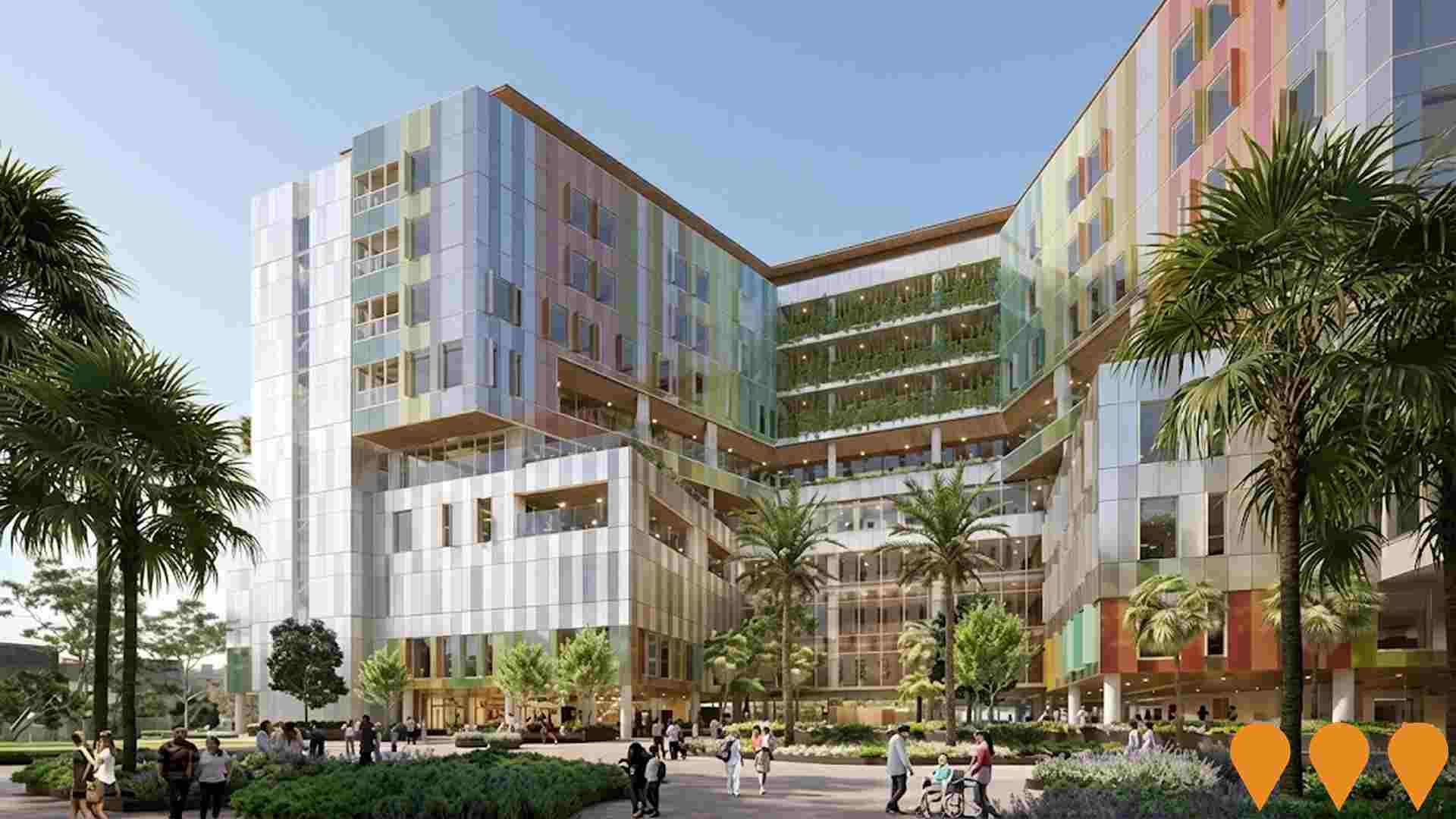
Prince of Wales Hospital Acute Services Building
The Prince of Wales Hospital Acute Services Building is a 13-storey, 55,000 square metre facility delivered as part of the Randwick Campus Redevelopment. It includes an expanded adult emergency department, intensive care unit, digital operating theatres, helipad, and additional inpatient beds. The building supports integrated health, research, and education within the Randwick Health and Innovation Precinct. Completed in 2022.

Mariyung Fleet (New Intercity Fleet)
The Mariyung Fleet is a 610-carriage double-deck electric train fleet being delivered by RailConnect NSW (UGL, Hyundai Rotem, Mitsubishi Electric Australia) for Transport for NSW. Named after the Darug word for emu, the fleet commenced passenger services on the Central Coast & Newcastle Line on 3 December 2024, followed by the Blue Mountains Line on 13 October 2025. Services on the South Coast Line are scheduled to commence in 2026. The fleet features modern amenities including spacious 2x2 seating, charging ports, improved accessibility with wheelchair spaces and accessible toilets, CCTV emergency help points, and dedicated spaces for luggage, prams and bicycles. The trains operate in flexible 4-car, 6-car, 8-car or 10-car formations. The fleet replaces aging V-set trains that entered service in the 1970s and serves approximately 26 million passenger journeys annually across the electrified intercity network. Supporting infrastructure includes the new Kangy Angy Maintenance Facility, platform extensions, and signaling upgrades at multiple stations.
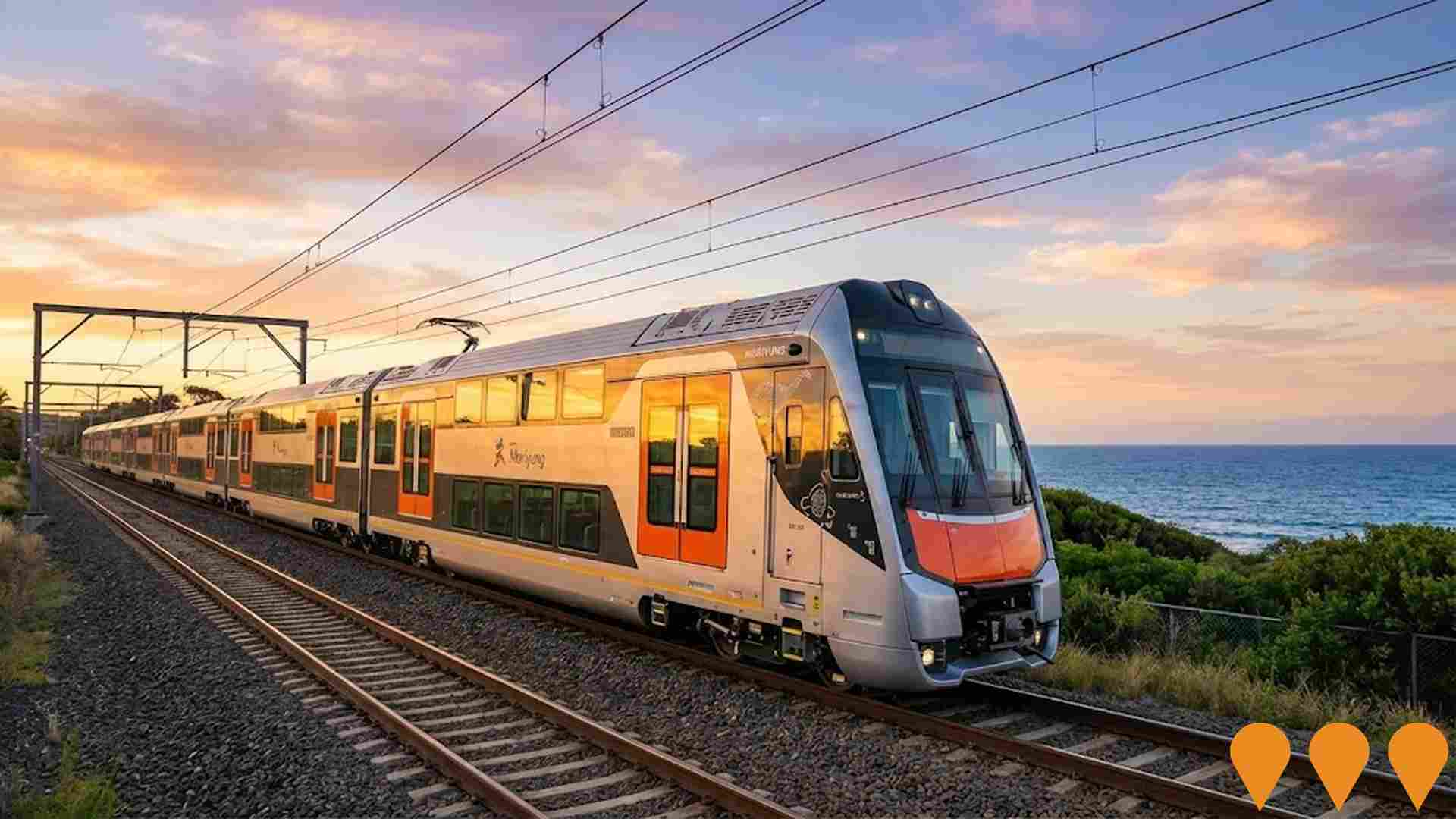
Google Pacific Connect - Tabua and Honomoana Cable Landing Infrastructure
Major subsea cable landing infrastructure for Google's Pacific Connect Initiative, supporting the Tabua and Honomoana transpacific cables connecting Australia to the United States, Fiji, and French Polynesia. Developed through Google's Perch Infrastructure in partnership with SUBCO, this project enhances digital resilience and international connectivity for Sydney and Australia. Construction includes horizontal directional drilling and shared landing infrastructure at Maroubra Beach.
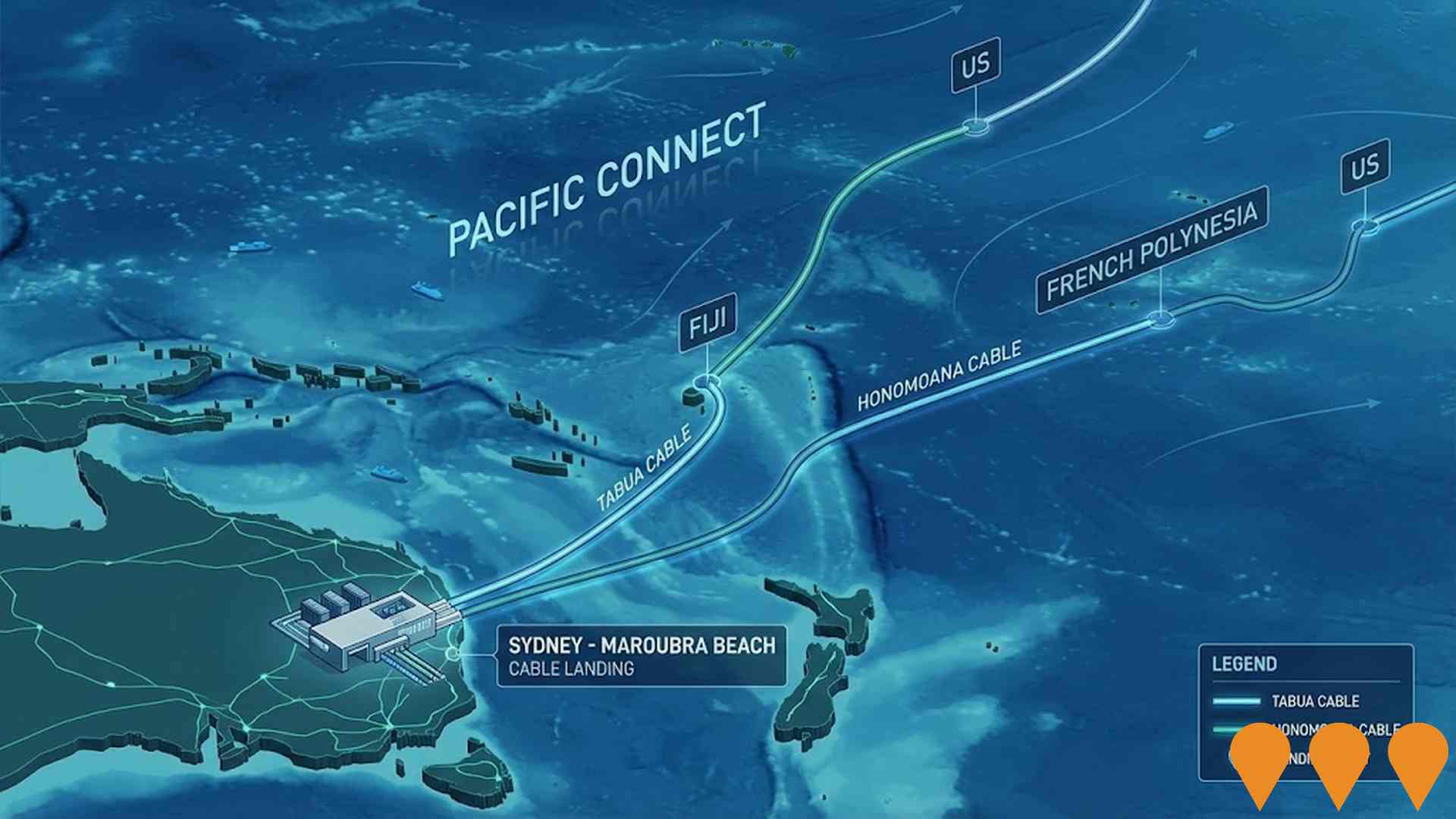
Rail Service Improvement Program (formerly More Trains More Services)
Program of staged upgrades across Sydney's heavy rail network to increase frequency and capacity through digital systems, track and signalling works, station upgrades and new or upgraded rollingstock. Formerly branded as More Trains More Services, the program continues delivery on lines including T4 Eastern Suburbs & Illawarra, T8 Airport & South, and integration works tied to broader network changes.

South Coogee to Lurline Bay Coastal Walk Connection
The project involves the development of a new public walkway connecting South Coogee to Lurline Bay through property acquisition and construction to complete the coastal walkway. Randwick City Council purchased a property for $4.9 million in November 2024 and is developing concept designs with community consultation planned for 2025-26.

Employment
The labour market performance in South Coogee lags significantly behind most other regions nationally
South Coogee has a highly educated workforce, with the technology sector notably represented. Its unemployment rate was 11.2% as of June 2025.
Employment growth over the past year was estimated at 6.7%. In June 2025, 2,736 residents were employed while the unemployment rate stood at 7.0%, above Greater Sydney's rate of 4.2%. Workforce participation was lower than standard (55.7% vs Greater Sydney's 60.0%). Dominant employment sectors include health care & social assistance, professional & technical, and education & training.
Public administration & safety shows strong specialization with an employment share of 1.4 times the regional level. Manufacturing representation is low at 2.7%, compared to the regional average of 5.7%. Employment opportunities locally appear limited based on Census data. From June 2024 to June 2025, employment levels increased by 6.7% and labour force grew by 2.5%, reducing unemployment by 3.5 percentage points. Greater Sydney recorded employment growth of 2.6% with unemployment rising slightly. National employment forecasts from May 2025 project a 6.6% increase over five years and 13.7% over ten years. Applying these projections to South Coogee's employment mix suggests local growth of approximately 7.3% over five years and 14.7% over ten years, though this is a simplified extrapolation for illustrative purposes.
Frequently Asked Questions - Employment
Income
Income metrics indicate excellent economic conditions, with the area achieving higher performance than 75% of national locations assessed by AreaSearch
AreaSearch's aggregation of postcode level ATO data for financial year 2022 shows South Coogee had a median taxpayer income of $77,979 and an average income of $130,664. These figures place South Coogee in the top percentile nationally, compared to Greater Sydney's median of $56,994 and average of $80,856. By September 2025, current estimates suggest a median income of approximately $87,812 and an average income of $147,141, based on Wage Price Index growth since financial year 2022. The 2021 Census data indicates that incomes in South Coogee cluster around the 73rd percentile nationally. Income analysis reveals 32.8% of South Coogee's population earn within the $40,000+ range, contrasting with the metropolitan region where the $1,500 - $2,999 bracket is most prevalent. The suburb shows income diversity, with 31.9% earning under $800 weekly and 41.0% exceeding $3,000 weekly, reflecting a mixed socioeconomic profile. High housing costs consume 16.2% of income in South Coogee, but strong earnings result in disposable income at the 73rd percentile nationally. The area's SEIFA income ranking places it in the 8th decile.
Frequently Asked Questions - Income
Housing
South Coogee features a more urban dwelling mix with significant apartment living, with a higher proportion of rental properties than the broader region
South Coogee's dwelling structures, as per the latest Census, consisted of 38.9% houses and 61.1% other dwellings (semi-detached, apartments, 'other' dwellings). In contrast, Sydney metro had 26.9% houses and 73.1% other dwellings. Home ownership in South Coogee stood at 25.8%, with mortgaged dwellings at 26.0% and rented ones at 48.3%. The median monthly mortgage repayment in the area was $4,000, higher than Sydney metro's average of $3,033. The median weekly rent figure for South Coogee was $207, compared to Sydney metro's $550. Nationally, South Coogee's mortgage repayments were significantly higher at $1,863, while rents were substantially lower at $375.
Frequently Asked Questions - Housing
Household Composition
South Coogee features high concentrations of lone person households, with a higher-than-average median household size
Family households constitute 65.3% of all households, including 35.3% couples with children, 17.9% couples without children, and 11.2% single parent families. Non-family households comprise the remaining 34.7%, with lone person households at 31.2% and group households making up 3.4%. The median household size is 2.6 people, larger than the Greater Sydney average of 2.4.
Frequently Asked Questions - Households
Local Schools & Education
South Coogee shows strong educational performance, ranking in the upper quartile nationally when assessed across multiple qualification and achievement indicators
Educational attainment in South Coogee is notably high, with 44.9% of residents aged 15+ holding university qualifications, compared to 30.4% nationally and 32.2% in NSW. Bachelor degrees are the most common at 28.7%, followed by postgraduate qualifications (13.3%) and graduate diplomas (2.9%). Vocational pathways account for 23.5% of qualifications, with advanced diplomas at 10.5% and certificates at 13.0%. Educational participation is high, with 34.7% of residents currently enrolled in formal education, including 11.3% in primary, 10.2% in secondary, and 7.1% in tertiary education.
South Coogee Public School serves the area, with an enrollment of 409 students as of a recent report. The school focuses exclusively on primary education, with ICSEA score of 1087, indicating above-average socio-educational conditions. Secondary options are available in surrounding areas. As of the same report, there are 7.1 school places per 100 residents in South Coogee, below the regional average of 11.1.
Frequently Asked Questions - Education
Schools Detail
Nearby Services & Amenities
Transport
Transport servicing is high compared to other areas nationally based on assessment of service frequency, route connectivity and accessibility
Analysis of public transport in South Coogee shows 26 active transport stops operating, all of which are bus stops. These stops are served by 21 different routes that collectively facilitate 2,126 weekly passenger trips. The accessibility of transport is rated as excellent, with residents typically located 125 meters from the nearest stop.
On average, there are 303 trips per day across all routes, which equates to approximately 81 weekly trips per individual stop.
Frequently Asked Questions - Transport
Transport Stops Detail
Health
The level of general health in South Coogee is notably higher than the national average with both young and old age cohorts seeing low prevalence of common health conditions
South Coogee shows superior health outcomes for both younger and older age groups, with low prevalence of common conditions. Private health cover stands at approximately 81%, compared to Greater Sydney's 70.6% and Australia's national average of 55.3%. Mental health issues affect 7.6% and arthritis impacts 6.9% of residents.
71.8% report no medical ailments, slightly lower than Greater Sydney's 76.0%. The area has a higher proportion of seniors at 18.3%, compared to Greater Sydney's 15.1%. Seniors' health outcomes are above average and align with the general population's profile.
Frequently Asked Questions - Health
Cultural Diversity
South Coogee was found to be more culturally diverse than the vast majority of local markets in Australia, upon assessment of a range of language and cultural background related metrics
South Coogee exhibited greater cultural diversity than most local areas, with 24.1% of residents speaking a language other than English at home and 34.5% born overseas. Christianity was the predominant religion in South Coogee, comprising 55.3% of its population. Notably, Judaism was overrepresented compared to Greater Sydney, making up 6.8% of South Coogee's population.
In terms of ancestry, the top three groups were English (21.3%), Australian (17.9%), and Other (12.4%). Certain ethnic groups showed significant differences in representation: Russian was overrepresented at 2.0%, French at 1.7%, and South African at 1.5%.
Frequently Asked Questions - Diversity
Age
South Coogee hosts an older demographic, ranking in the top quartile nationwide
The median age in South Coogee is 42 years, which is significantly higher than Greater Sydney's average of 37 years and Australia's median age of 38 years. The age group of 55-64 years has a strong representation at 12.8% compared to the Greater Sydney average. However, the 25-34 year cohort is less prevalent in South Coogee at 11.6%. According to post-2021 Census data, the 25 to 34 age group has grown from 9.5% to 11.6%, while the 15 to 24 age group increased from 11.9% to 13.7%. Conversely, the 45 to 54 age group has declined from 15.5% to 14.1%, and the 35 to 44 age group dropped from 12.5% to 11.2%. Population forecasts for South Coogee in 2041 indicate substantial demographic changes. The 45 to 54 age group is expected to grow by 55% (447 people), reaching a total of 1,256 from the previous count of 808. Conversely, the 0 to 4 and 5 to 14 age cohorts are projected to experience population declines.

